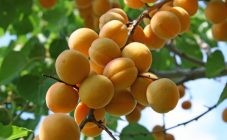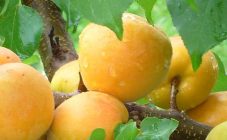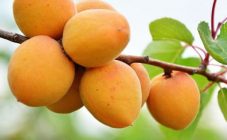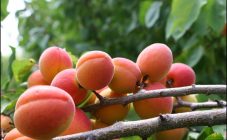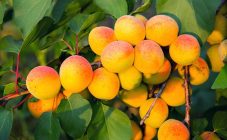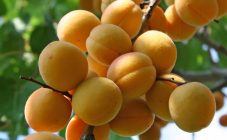Content:
The Alyosha variety was first obtained in 1988 thanks to domestic breeders: Professor A.K. Skvortsov and biologist L.A. Kramarenko. They wanted to achieve a frost-resistant, early-maturing and disease-resistant variety. In 2004, the variety was included in the State Register of Breeding Achievements. It gained its fame thanks to its excellent taste and presentation. It is grown on the territory of the Moscow region and Central Russia.
Apricot Alyosha: variety description
The apricot tree can grow up to 4 m in height. It has a rounded, spreading, wide and dense crown. Its diameter can reach 4 m. Due to the rapid growth of the tree, the first fruits can be obtained in 3 years. The apricot blooms early. The flowers are large, white in color with pinkish veins with a diameter of 3.5-4 cm. This variety is capable of self-pollinating flowers. The leaves of the tree are large enough, rich green. With the onset of autumn, they acquire yellow, red and crimson tones.
The main differences of the variety are winter hardiness, frost resistance and drought resistance. If in the spring there is a low air temperature for a long time, then the trunk must be whitened so that the tree blooms later.
The apricot ripens early. Harvesting can be done at the end of July or in the first half of August. Although self-fertile, it can serve as a good pollinator for other varieties. The yield is high. From 1 hectare, you can easily collect 45 centners of fruits.
Alyosha varietal apricot has small rounded fruits. The surface of the peel is smooth with a light fluff. The weight of the berries can vary from 15 to 20 g. Due to their small size, they are convenient for processing. The color of the fruit is orange-yellow with a bright blush on the sides. The pulp is juicy and tender orange hue with a sweet and sour taste. The size of the stone is quite large. It can be easily separated from the ripe pulp.
Due to its taste, the apricot can be eaten fresh, as well as making jam or apricot juice. The variety has a long shelf life. Fruits can be stored in a cool place for 2 to 3 weeks. When transported over short distances, they should be kept in low and well-ventilated boxes.
Landing
The Alyosha variety has sufficient resistance to common pests and diseases, especially to such as monoliosis and klyasternosporiosis. Such fungal diseases can lead to the death and shedding of leaves. The main reasons are temperature drops and high humidity. With proper planting and tree care, diseases can be avoided.
The choice of planting material
Before planting, you should choose the right seedlings. They should be between 1 and 2 years old. Such seedlings adapt better to a new place and will tolerate spring frosts well. The roots should be firm and smooth without build-up. Seedlings that were left for storage in the autumn should be cut by 1/3 of their length before planting and damaged dry shoots should be removed.
In special stores you can find Alyosha apricot seedlings in pots filled with soil. Plants in such containers will perfectly take root at any time of planting.
Landing place
An important part of planting is choosing a place for the tree.It must be dry, sufficiently lit and well ventilated. To better protect the plant from frost, it should be planted near buildings that will help protect the tree from the cold wind.
Planting is recommended on loamy or sandy loam soil. Heavy clay or sandy soil will not work as the plant will grow slowly. Also, an important factor is the acidity of the soil, which should be within 7.0 pH. High acidity can negatively affect seeds and fruits, which will crack. To fix this, dolomite flour or other alkalizing agent can be added to the soil during planting.
You should not allow an abundance of moisture near the trunk, as the likelihood of flooding increases, due to which the tree may die. To prevent this, you should do drainage in the planting pit or land on a hill.
Care rules
The variety is unpretentious to the composition of the soil and does not require careful personal care. However, there are a few rules to follow before boarding. Below is a description of planting an apricot:
- If seedlings with an open root system, then planting is carried out in spring, and for seedlings in containers - from early spring to October. The plant should not be tamped deeply into the soil.
- It is recommended to allocate a plot of at least 12 m² for one tree.
- Also, for this variety, pruning of branches by a third is necessary, during which it is important not to hurt the roots. Thus, the plant adapts to a new place much faster.
- Having planted a tree in a hole, humus or horse humus is introduced into it. Potassium chloride (20 g) or superphosphates (30 g) can be added if desired.
- After some time, the tree is fed several times: before flowering and when the ovaries fall off. For this, nitrogen fertilizers are used. At the beginning of autumn, it is recommended to add potassium salt (100 g) and superphosphate (150 g). In the future, only organic matter is introduced (chicken droppings, manure).
- At the first time, when planting takes place, most of the flowers are cut off, and in the next - half less.
- Watering is carried out 5-6 times a month. One tree requires 2-3 buckets in the morning and evening. With the onset of July, watering can be stopped, but if the weather is dry, then it continues.
- A trunk circle is made near the tree. It is loosened and excess weeds are removed.
- To protect the tree from rodents, nylon tights or special nets are used.
- Also, the variety needs pollinators, otherwise the apricot will not be able to please with a high yield.
To get a much larger harvest and protect the tree from pests, branches are pruned. This should be done, taking into account some of the nuances:
- Pruning of branches is carried out annually before bud break.
- Cut them off at the very base of the trunk. First of all, the recumbent branches are removed, which may break in the future due to the severity of the fruit. In addition, limp and dry shoots are cut off.
- If the growth of the tree is quite active, then 15 cm can be considered an acceptable pruning.
- It is important to cut no more than ¼ of the total number of branches.
- Thinning of the tree should also be carried out to prevent pests and diseases.
Advantages and disadvantages of the variety
The Alyosha variety has gained wide popularity due to a number of its positive qualities:
- early ripening of fruits;
- high taste and marketability;
- Alyosha variety perfectly tolerates drought and frost;
- sufficient resistance to diseases and pests;
- high productivity;
- keeping quality and transportability of fruits;
- not picky about care.
Perhaps the only drawback is the large size of the seed, which increases the percentage of waste when processing apricot.
Based on the above characteristics, such a variety of varieties can be grown with confidence in any summer cottage. Apricot (Alyosha variety) is famous for its rich harvest, while not causing any trouble to care for it.Such a variety will easily endure any frost and drought and will be able to produce many tasty and healthy fruits that will be suitable not only for conservation, but also for fresh consumption.


